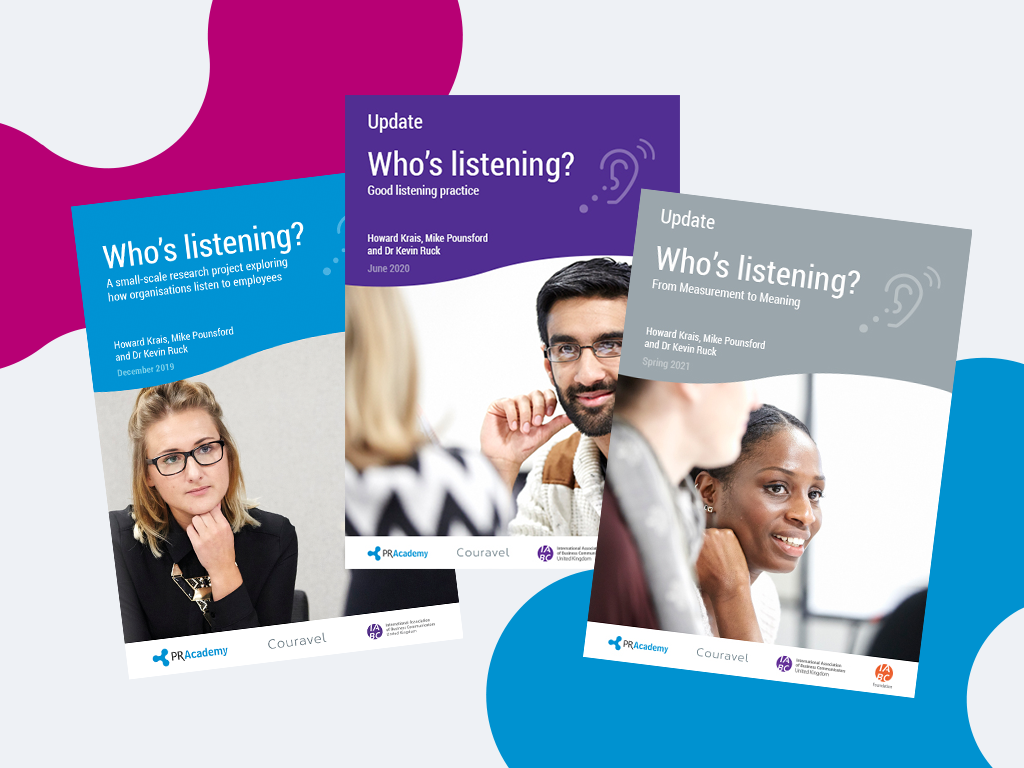— April 13th, 2021
One of the key findings from the latest ‘Who’s Listening?’ research report published this week is the dominance of surveys and the underutilization of focus groups and digital listening.
Over the past two years, Howard Krais, Mike Pounsford and myself have conducted interviews, run workshops and examined case studies. And in this latest report, we delve deep into approaches to listening through a global survey with more than 500 communication managers.
Many critics see the ‘employee survey industry’ as the antithesis of good listening. The constant cycle of questionnaires often appears to meet a management need to count opinions rather than an employee’s need to feel that their opinion counts.
The constant cycle of questionnaires often appears to meet a management need to count opinions rather than an employee’s need to feel that their opinion counts.
Despite the growth in new digital tools, the results of our study clearly illustrate that surveys dominate the way organizations listen.
We found that the ‘large-scale engagement survey’ is used by 59 percent of respondents at least annually and is mentioned most often as the approach delivering insights.
The Changed Workplace 2021: How employees feel and what leaders and communicators need to do about it
Additionally, 35 percent of respondents said that pulse surveys are used monthly, quarterly or on an ongoing basis. In contrast, 77 percent of respondents stated that focus groups were rarely or never used. This suggests that there is a broad under-appreciation of the insights that focus groups generate.
We acknowledge the benefits of surveys - they provide a comprehensive overview of opinion and enable comparative data analysis across functions, areas, and time.
Differences or trends can be ascribed to events or processes which can be reviewed and changed or improved. Anonymity is also an important aspect of a survey – something that was raised many times in open comments in our research.
But what also stands out from open comments is the importance of ‘face to face’ interaction (it may be virtual or physical) where employees can talk about their opinions and emotions – often with leadership there to hear and respond.
Focus groups or dedicated listening sessions demonstrate a concern for the views of employees and generate deeper insights through more open and free-ranging discussion of experiences. Although they may appear to be more difficult and time-consuming to organize, focus groups are well worth the effort.
Perhaps the most surprising result in our latest research is that 53 percent of respondents agreed that employees are more comfortable speaking up on internal digital platforms than in other settings (19 percent disagreed).
At the same time, 58 percent of respondents rarely or never monitor discussions on digital platforms. This suggests that a method of expressing views that employees are comfortable with using is the one that is not used very much for listening.
Furthermore, reviewing discussions on internal digital platforms is more strongly associated with beneficial outcomes such as generating good ideas on how to work effectively than other listening methods used on an ongoing basis.
As organizations move to a hybrid model of working this year, digital will play an important role in future organizational listening strategies. However, there are also some issues with digital listening. These include:
- Low participation (often, significantly, including leaders) in online forums and discussions
- Ethical concerns that digital listening feels like eavesdropping if employees are unaware that discussions will be monitored
- The problems of access being limited for some groups of employees because of the nature of their work.
The potential for insights from digital listening should not be under-estimated. A combination of pulse surveys, increased use of focus groups, and better internal digital listening are the cornerstones for any listening plan.
Get this right and organizations will see tangible benefits such as effective change management, the generation of good ideas for effective working, responding well to changes, and the creation of innovative new products and services.
This blog by Dr. Kevin Ruck is based on the findings of the latest Who's Listening research report, From Measurement to Meaning, which you can download here.

